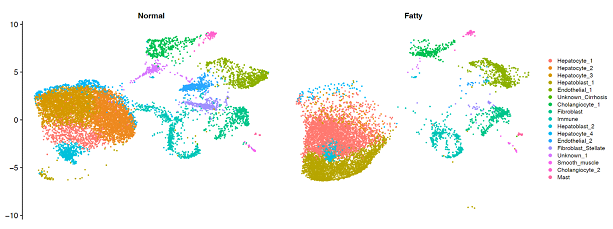Molecular Characterization of Progressive Fibrosis in the Liver by Single-Nuclei RNA Sequencing
1Surgical Sciences, University of Maryland Baltimore, Baltimore, MD, 2Transplantation Program, University of Maryland Medical Center, Baltimore, MD
Meeting: 2022 American Transplant Congress
Abstract number: 1431
Keywords: Fibrosis, Liver cirrhosis
Topic: Clinical Science » Liver » 53 - Liver: Cirrhosis - Portal Hypertension and Other Complications
Session Information
Session Name: Liver: Cirrhosis - Portal Hypertension and Other Complications
Session Type: Poster Abstract
Date: Monday, June 6, 2022
Session Time: 7:00pm-8:00pm
 Presentation Time: 7:00pm-8:00pm
Presentation Time: 7:00pm-8:00pm
Location: Hynes Halls C & D
*Purpose: The prevalence of obesity is negatively affecting the availability of livers for transplantation. Non-alcoholic fatty liver disease (NAFLD) is associated with an increase in inflammatory processes which potentially contribute to the exacerbation of fibrosis and development of cirrhosis. Hereby, we assess the use of single-nucleus RNA sequencing to identify the molecular mechanisms by which NAFLD progresses towards fibrosis at the single-cell resolution to derive therapies with potential to rescue organs from being discarded.
*Methods: Single nuclei isolated from flash-frozen samples included normal, NAFLD, non-alcoholic steatohepatitis (NASH), and cirrhosis. Cell types were analyzed for differentially expressed genes, which were further characterized by the predictive subcellular localization of the associated translated protein. Gene sets predicted to localize to the nucleus, cytosol, and mitochondria were individually explored for KEGG/GO-term enrichment and pathway analysis.
*Results: Four hepatocyte (HEP) clusters and two hepatoblast (HpB) clusters were identified. HEP-1 and HpB-1 were found to be expressed almost exclusively in NAFLD. Gene clusters associated with mitochondria-localized gene products within HpB-1 were enriched for GO-terms specific to fatty acid oxidation and an upregulation of reducing power. In contrast, HEP-1 was found to be enriched for oxidative stress localized to the cytosol and have an increased reliance on amino acid metabolism, specifically the catabolism of branched chain amino acids by the upregulated activity of MCCC1, DBT, and HIBCH. Taken together, these findings would suggest a progression of metabolic dysfunction from HpB-1 to HEP-1. In addition, these two cell types were also found to have a significantly higher concentration of genes associated with ECM production. Further study is needed to determine the cellular pathways by which these cell types progress to NASH and further to Cirrhosis.
*Conclusions: In this study, we identify two cell types exclusively found in NAFLD which show an upregulated response to oxidative stress and fibrogenic mechanisms in light of progressive metabolic dysregulation. With continued progression, on-set of fibrosis lends to the eradication of hepatocytes and replacement of epithelial cells with fibrotic cells, thereby highlighting the cellular shift from NAFLD to Cirrhosis.
To cite this abstract in AMA style:
Rousselle T, McDaniels J, Shetty A, Bardhi E, Polsky D, Williams E, Maluf D, Mas V. Molecular Characterization of Progressive Fibrosis in the Liver by Single-Nuclei RNA Sequencing [abstract]. Am J Transplant. 2022; 22 (suppl 3). https://atcmeetingabstracts.com/abstract/molecular-characterization-of-progressive-fibrosis-in-the-liver-by-single-nuclei-rna-sequencing/. Accessed December 31, 2025.« Back to 2022 American Transplant Congress

